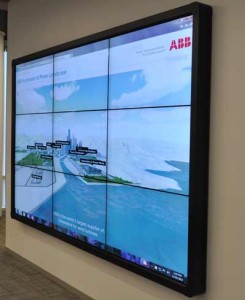A venue, business, or even an artist can make excellent use of a videowall. People are naturally drawn to this technology, which consists of many small displays unified into a larger installation. A unified set of displays offers much more versatility over a single monitor, and is more practical when a venue needs something larger. Obviously, though, setting up a bank of monitors is technically more complex and requires extra infrastructure to handle, so it’s a project that should be done under the guidance of an AV expert. A single display loses fidelity at larger sizes, and is also more fragile. The goal is to maintain adequate pixel densities at greater sizes, but that’s harder to manage with a single display. That’s a primary reason why venues like stadiums and concert halls often prefer several displays, as it produces a higher resolution image at multiple distances. A videowall also confers more precise control over the display, as each monitor can be set to produce a different image. With this power, even libraries and airports can make effective use of the technology. Artists also take advantage of this function, creating mosaics of images and type to produce unique designs.
Installing multiple monitors requires sturdier supports, additional graphic processors and cards, more power, and more cables. It is an advanced project that is best left to an experienced professional – one like Data Projections.
A single display loses fidelity at larger sizes, and is also more fragile. The goal is to maintain adequate pixel densities at greater sizes, but that’s harder to manage with a single display. That’s a primary reason why venues like stadiums and concert halls often prefer several displays, as it produces a higher resolution image at multiple distances. A videowall also confers more precise control over the display, as each monitor can be set to produce a different image. With this power, even libraries and airports can make effective use of the technology. Artists also take advantage of this function, creating mosaics of images and type to produce unique designs.
Installing multiple monitors requires sturdier supports, additional graphic processors and cards, more power, and more cables. It is an advanced project that is best left to an experienced professional – one like Data Projections.
 A single display loses fidelity at larger sizes, and is also more fragile. The goal is to maintain adequate pixel densities at greater sizes, but that’s harder to manage with a single display. That’s a primary reason why venues like stadiums and concert halls often prefer several displays, as it produces a higher resolution image at multiple distances. A videowall also confers more precise control over the display, as each monitor can be set to produce a different image. With this power, even libraries and airports can make effective use of the technology. Artists also take advantage of this function, creating mosaics of images and type to produce unique designs.
Installing multiple monitors requires sturdier supports, additional graphic processors and cards, more power, and more cables. It is an advanced project that is best left to an experienced professional – one like Data Projections.
A single display loses fidelity at larger sizes, and is also more fragile. The goal is to maintain adequate pixel densities at greater sizes, but that’s harder to manage with a single display. That’s a primary reason why venues like stadiums and concert halls often prefer several displays, as it produces a higher resolution image at multiple distances. A videowall also confers more precise control over the display, as each monitor can be set to produce a different image. With this power, even libraries and airports can make effective use of the technology. Artists also take advantage of this function, creating mosaics of images and type to produce unique designs.
Installing multiple monitors requires sturdier supports, additional graphic processors and cards, more power, and more cables. It is an advanced project that is best left to an experienced professional – one like Data Projections.


